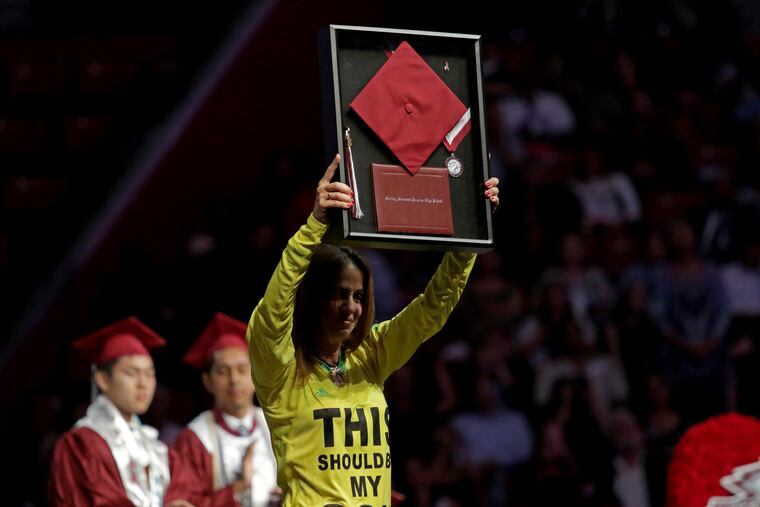Teachers now lead mass-shooting drills, but it’s not just up to educators to save lives | Perspective
When our students' greatest concern isn't about an upcoming math test but about a potential massacre, when graduation ceremonies are marked not by letters of academic achievement but by the presentation of tactical gear, we all must reconsider our role in effecting change.

For teachers, June is a time of recognizing student achievement, of reflecting on the year that was and looking forward to the summer ahead. However, for a group of graduates in Pennsylvania, this week was not a time of joy but a reminder of how dangerous school has become.
The eighth-grade class of St. Cornelius Catholic School in Chadds Ford received a parting gift to commemorate graduation. That gift? A SafeShield, a bulletproof insert students can place into their backpacks in the event of a mass shooting. It was a stark reminder that not all students who clamor onto yellow buses each morning make it home.
I led my first mass shooting drill in January 2013, a month after the horrific Sandy Hook massacre. My colleagues and I spent hours developing plans. Was it better to escape or to shelter in place or to fight back with the blocks and tennis balls a police captain had advised we have on hand? Which students might freeze? Which might run? My classroom was less than 10 seconds from the school's entrance. What could that mean?
>> READ MORE: Nothing has stopped the wave of school shootings. Now districts are buying war-zone trauma kits
"Once America decided killing children was bearable, it was over," British journalist Dan Hodges tweeted, citing Sandy Hook. Indeed, as I installed blackout curtains and introduced my students to our designated hiding space (bring a book to read silently, word directions carefully so no one's alarmed, present the drill as a game), I waited for legislative change that never came.
During the 2017-18 year, there has been, on average, a school shooting every single week of the year. While guns-rights advocates have come up with an appalling list of anti-solutions, what they're unwilling to do is have a productive conversation on gun reform. As the eighth graders at St. Cornelius, let alone the students of Parkland, Santa Fe and other communities can attest, those of us responsible for protecting students have failed.
Most Americans support stricter gun control laws. The challenge is that those on either side of the debate are so quick to shout their own views they don't take the time to consider others' perspectives.
Despite its well-reported downsides, social media can be a tool for change, and there's no group more equipped to demonstrate this than our students. Parkland survivors are joining with teens across the nation to speak out against gun violence and are collaborating with organizations like The Giffords Law Center, Everytown for Gun Safety, Sandy Hook Promise, and the Brady Campaign to promote change. It is important to note that not one of these organizations advocates for a total revocation of the Second Amendment or demands an unconditional ban on guns. Instead, they offer measured, effective proposals rooted in research and with proven track records for saving lives. In effect, they're doing what any good teacher expects of her class — research the facts, formulate a plan, and develop a reasonable solution.
The good news is, we know what works. After the Sandy Hook shootings, Connecticut enacted strict legislation designed to prevent future mass shootings. In the four years following implementation of the regulations, gun deaths in the state fell nearly 28 percent. Today, Connecticut, along with New York, which passed even stricter legislation during the same time period, ranks in the top five states with fewest gun deaths per capita. These are by no means comprehensive changes nor the only answers, but they're a definite start.
We encourage students to learn good citizenship, cooperation, and critical thinking skills, while we, as adults, embrace greed, selfishness, and a willingness to accept the opinions of like-minded others as incontrovertible fact. For years, we have collectively decided that protecting our children isn't worth the effort. And yet, when our students' greatest concern isn't about an upcoming math test but about a potential massacre, when graduation ceremonies are marked not by letters of academic achievement but by the presentation of tactical gear, we all must reconsider our role in effecting change.
A teacher's primary responsibility is to educate, not to coach students through mass shooting drills or pass out bulletproof backpacks. Parents entrust their children to me at the start of the school day, but it is everyone's responsibility to ensure they return home safely each night.
Samantha Facciolo is an educator currently serving as a writer-in-residence in the New York City public schools. @seesamwrite